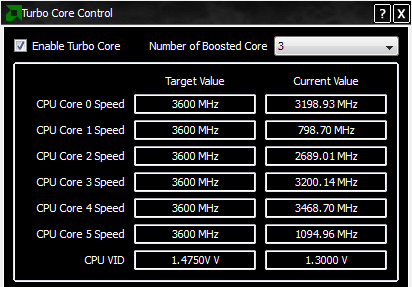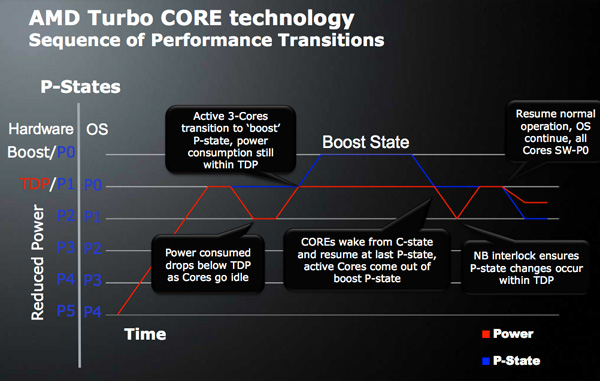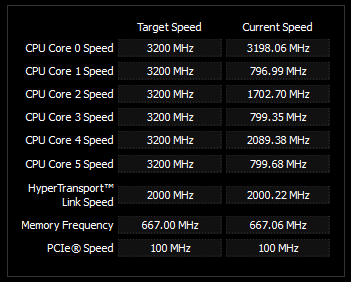AMD's Six-Core Phenom II X6 1090T & 1055T Reviewed
by Anand Lal Shimpi on April 27, 2010 12:26 AM EST- Posted in
- CPUs
- AMD
- Phenom II X6
AMD’s Turbo: It Works
In the Pentium 4 days Intel quickly discovered that there was a ceiling in terms of how much heat you could realistically dissipate in a standard desktop PC without resorting to more exotic cooling methods. Prior to the Pentium 4, desktop PCs saw generally rising TDPs for both CPUs and GPUs with little regard to maximum power consumption. It wasn’t until we started hitting physical limits of power consumption and heat dissipation that Intel (and AMD) imposed some limits.
High end desktop CPUs now spend their days bumping up against 125 - 140W limits. While mainstream CPUs are down at 65W. Mobile CPUs are generally below 35W. These TDP limits become a problem as you scale up clock speed or core count.
In homogenous multicore CPUs you’ve got a number of identical processor cores that together have to share the maximum TDP of the processor. If a single hypothetical 4GHz processor core hits 125W, then fitting two of them into the same TDP you have to run the cores at a lower clock speed. Say 3.6GHz. Want a quad-core version? Drop the clock speed again. Six cores? Now you’re probably down to 3.2GHz.
| Single Core | Dual Core | Quad Core | Hex Core |
 |
 |
 |
 |
 |
 |
 |
 |
This is fine if all of your applications are multithreaded and can use all available cores, but life is rarely so perfect. Instead you’ve got a mix of applications and workloads that’ll use anywhere from one to six cores. Browsing the web may only task one or two cores, gaming might use two or four and encoding a video can use all six. If you opt for a six core processor you get great encoding performance, but worse gaming and web browsing performance. Go for a dual core chip and you’ll run the simple things quickly, but suffer in encoding and gaming performance. There’s no winning.
With Nehalem, Intel introduced power gate transistors. Stick one of these in front of a supply voltage line to a core, turn it off and the entire core shuts off. In the past AMD and Intel only put gates in front of the clock signal going to a core (or blocks of a core), this would make sure the core remained inactive but it could still leak power - a problem that got worse with smaller transistor geometries. These power gate transistors however addressed both active and leakage power, an idle core could be almost completely shut off.
If you can take a single core out of the TDP equation, then with some extra logic (around 1M transistors on Nehalem) you can increase the frequency of the remaining cores until you run into TDP or other physical limitations. This is how Intel’s Turbo Boost technology works. Depending on how many cores are active and the amount of power they’re consuming a CPU with Intel’s Turbo Boost can run at up to some predefined frequency above its stock speed.

With Thuban, AMD introduces its own alternative called Turbo Core. The original Phenom processor had the ability to adjust the clock speed of each individual core. AMD disabled this functionality with the Phenom II to avoid some performance problems we ran into, but it’s back with Thuban.
If half (or more) of the CPU cores on a Thuban die are idle, Turbo Core does the following:
1) Decreases the clock speed of the idle cores down to as low as 800MHz.
2) Increases the voltage of all of the cores.
3) Increases the clock speed of the active cores up to 500MHz above their default clock speed.

The end result is the same as Intel’s Turbo Boost from a performance standpoint. Lightly threaded apps see a performance increase. Even heavily threaded workloads might have periods of time that are bound by the performance of a single thread - they benefit from AMD’s Turbo Core as well. In practice, Turbo Core appears to work. While I rarely saw the Phenom II X6 1090T hit 3.6GHz, I would see the occasional jump to 3.4GHz. As you can tell from the screenshot above, there's very little consistency between the cores and their operating frequencies - they all run as fast or as slow as they possibly can it seems.
| AMD's Turbo Core Benefit | |||||
| AMD Phenom II X6 1090T | Turbo Core Disabled | Turbo Core Enabled | Performance Increase | ||
| x264-HD 3.03 1st Pass | 71.4 fps | 74.5 fps | 4.3% | ||
| x264-HD 3.03 2nd Pass | 29.4 fps | 30.3 fps | 3.1% | ||
| Left 4 Dead | 117.3 fps | 127.2 fps | 8.4% | ||
| 7-zip Compression Test | 3069 KB/s | 3197 KB/s | 4.2% | ||
Turbo Core generally increased performance between 2 and 10% in our standard suite of tests. Given that the max clock speed increase on a Phenom II X6 1090T is 12.5%, that’s not a bad range of performance improvement. Intel’s CPUs stand to gain a bit more (and use less power) from turbo thanks to the fact that Lynnfield, Clarkdale, et al. will physically shut off idle cores rather than just underclock them.

I have noticed a few situations where performance in a benchmark was unexpectedly low with Turbo Core enabled. This could be an artifact of independent core clocking similar to what we saw in the Phenom days, however I saw no consistent issues in my time with the chip thus far.










168 Comments
View All Comments
JGabriel - Tuesday, April 27, 2010 - link
Good point - and yes, it does. But revenue from the microprocessor unit also increased by 23%, according to Businessweek ( http://www.businessweek.com/idg/2010-04-15/amd-swi... )..
kenupcmac - Wednesday, December 1, 2010 - link
so now amd x6 is better for 3dmax compare to intel i7?Drazick - Tuesday, April 27, 2010 - link
Could you add some Matlab Benchmarks?Moreover, do you think most of the performances advantage of Intel processors comes from highly optimized code (Towards Intel Cores)?
It's something that should be investigated.
gruffi - Wednesday, April 28, 2010 - link
Yes, absolutely. I wished more GCC builds would be benchmarked. Intel's architecture is not as good as many people believe. Most of Intel's advantages come from better software support.pjconoso - Tuesday, April 27, 2010 - link
Intel 6-core early adopters will feel like they were ripped-off. I have the Asus USB 3.0 (for review) for a few weeks now and I'm waiting for this processor to test it with - thanks for the review, I'm sure it'll help me a lot.Scali - Tuesday, April 27, 2010 - link
Ripped off? Why?The performance of this six-core is nowhere near the Intel 980X.
This six-core can barely keep up with Intel's faster quadcores.
pjconoso - Tuesday, April 27, 2010 - link
Well, in my opinion the difference in performance versus the price doesn't justify it. They look nice in a bar graph and all like the video encoding performance but in reality, its just a few seconds.fitten - Tuesday, April 27, 2010 - link
It's all "just a few seconds". I'm going to wait for the Intel's consumer-priced hex-cores before I do anything. Right now, AMD needs 50% more cores to even match Intel's parts in heavily threaded code. Running out right now and buying all new kit might be leaving you feeling like "cores on the ground" if Intel comes out with the consumer-priced stuff. ;)Scali - Tuesday, April 27, 2010 - link
Price/performance has always been on an exponential scale.AMD was no different when their Athlon FX were the fastest CPUs around.
Intel doesn't call them Extreme Edition for nothing.
I just get tired of people who go around on the internet telling everyone that Intel only has $1000 CPUs, and therefore Intel is overpriced.
The fastest PC on the market is just $1000, has been like that for decades, regardless of whether it was an AMD or Intel. Just seems to be how the market works.
pjconoso - Tuesday, April 27, 2010 - link
I just get tired of people who go around on the internet telling everyone that Intel only has $1000 CPUs, and therefore Intel is overpriced.Sorry man, but this isn't what I'm implying which is why there is a "in my opinion" on my explanation. It was really just a personal opinion, nothing else.